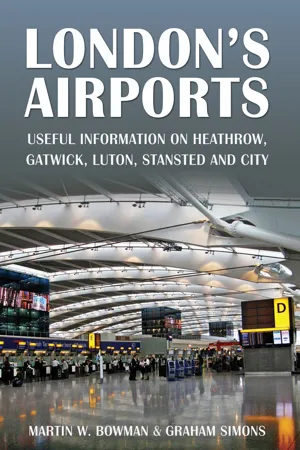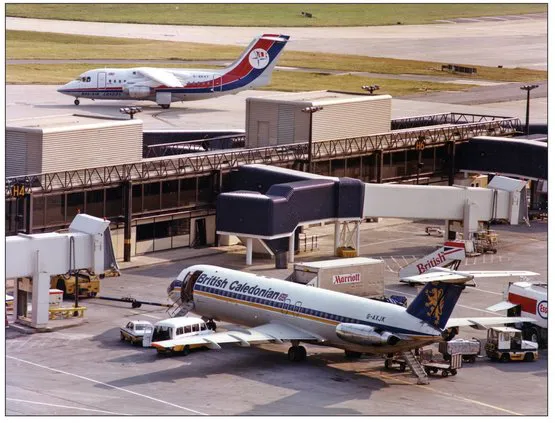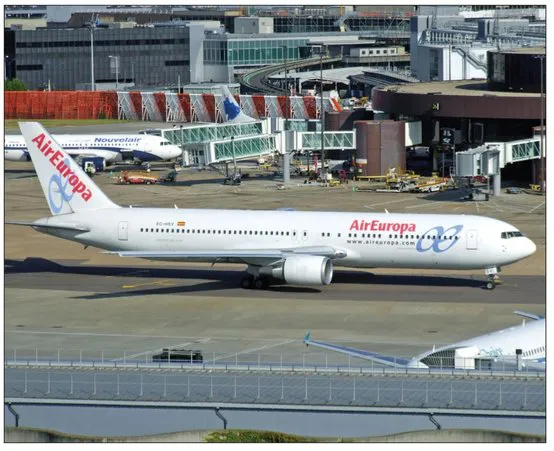
eBook - ePub
London's Airports
Useful Information on Heathrow, Gatwick, Luton, Stansted and City
- 138 pages
- English
- ePUB (mobile friendly)
- Available on iOS & Android
eBook - ePub
London's Airports
Useful Information on Heathrow, Gatwick, Luton, Stansted and City
About this book
This book is for the passengers and aviation buffs who use Londons main airports. It includes a brief history, plans and photographs for each of the five airports, together with directions and information about gates, security, passport control, shopping, restaurants, car parks and other transport connections. Details of Air Traffic Control in London airspace is explained with the inclusion of aerial photographs taken during approach to landing so passengers may locate places of interest whilst flying.
Frequently asked questions
Yes, you can cancel anytime from the Subscription tab in your account settings on the Perlego website. Your subscription will stay active until the end of your current billing period. Learn how to cancel your subscription.
No, books cannot be downloaded as external files, such as PDFs, for use outside of Perlego. However, you can download books within the Perlego app for offline reading on mobile or tablet. Learn more here.
Perlego offers two plans: Essential and Complete
- Essential is ideal for learners and professionals who enjoy exploring a wide range of subjects. Access the Essential Library with 800,000+ trusted titles and best-sellers across business, personal growth, and the humanities. Includes unlimited reading time and Standard Read Aloud voice.
- Complete: Perfect for advanced learners and researchers needing full, unrestricted access. Unlock 1.4M+ books across hundreds of subjects, including academic and specialized titles. The Complete Plan also includes advanced features like Premium Read Aloud and Research Assistant.
We are an online textbook subscription service, where you can get access to an entire online library for less than the price of a single book per month. With over 1 million books across 1000+ topics, we’ve got you covered! Learn more here.
Look out for the read-aloud symbol on your next book to see if you can listen to it. The read-aloud tool reads text aloud for you, highlighting the text as it is being read. You can pause it, speed it up and slow it down. Learn more here.
Yes! You can use the Perlego app on both iOS or Android devices to read anytime, anywhere — even offline. Perfect for commutes or when you’re on the go.
Please note we cannot support devices running on iOS 13 and Android 7 or earlier. Learn more about using the app.
Please note we cannot support devices running on iOS 13 and Android 7 or earlier. Learn more about using the app.
Yes, you can access London's Airports by Martin W. Bowman,Graham M. Simons in PDF and/or ePUB format, as well as other popular books in History & Military & Maritime History. We have over one million books available in our catalogue for you to explore.
Information
CHAPTER ONE
Gatwick
Gatwick was formally developed as a major airport in 1958 following an investment of £7.8 million, before which it was only used by a small number of commercial aircraft. It is the second-largest airport serving London and the South-East of England, and the second-busiest airport in the UK after Heathrow. The airport also has the distinction of being the busiest single-runway airport and ninth-busiest airport in the world in terms of passengers per year (handling nearly 34.2 million in 2008).
The name ‘Gatwick’ dates back to 1241, and it was the name of a manor on the site of today’s airport until the nineteenth century. It is derived from the Anglo-Saxon words gāt, (‘goat’) and wīc (‘dairy farm’), i.e. ‘goat farm’. In 1891, a racecourse was created beside the London – Brighton railway, and a station included sidings for horse-boxes. The course held steeplechase and flat races. During the First World War the course hosted the Grand National. In the late 1920s, land adjacent to the racecourse at Hunts Green Farm along Tinsley Green Lane was used as an aerodrome. Following a change in land ownership, the aerodrome was licensed in August 1930. Surrey Aero Club was formed in 1930 and used the old Hunts Green farmhouse as a clubhouse. Redwing Aircraft Company bought the aerodrome in 1932 and operated a flying school. The aerodrome was also used for pilots flying in to races. In September 1933 A.M. (Morris) Jackaman, who owned several light aircraft, bought the aerodrome. He had bold ideas for its future, such as expanding it for use as a relief aerodrome for London (Croydon) Airport and for providing a regular service to Paris, using de Havilland DH.84 Dragon aircraft. Overcoming resistance from the Air Ministry, which was concerned about the cost of draining the land and diverting the River Mole, Jackaman oversaw Gatwick’s transition to a public aerodrome, which was licensed for non-private flights in 1934.
Jackaman raised money by floating his company, Airports Ltd, on the stock exchange. Other revenue came from the Air Ministry, which paid for the right to use Gatwick as a diversionary destination at times when Croydon Aerodrome was inaccessible. In 1935 Hillman’s Airways, which merged to form the company that became known as the original British Airways, made Gatwick its operational base, thus increasing its commercial viability and providing more finance. The aerodrome closed on 6 July 1935 to allow a terminal to be built. Jackaman and his contemporaries considered terminals at other aerodromes to be impractical and unsuitable for expansion, so a ‘proper’ one was planned for Gatwick, linked to a new railway station on the adjacent Brighton main line. The circular terminal building – reputedly in response to a throwaway comment by his father – was designed by architects Hoar, Marlow and Lovett in accordance with the design provided by Jackaman, who submitted a patent application for the concept on 8 October 1934. Advantages claimed for the design, which soon became known as the ‘Beehive’, included efficient use of space and greater safety of aircraft movements.

This Comet 4B served British European Airways, Channel Airways and finally Dan Air before retiring in 1978. It was then used for training aircrew at Gatwick.
A typical day at Gatwick in the 1980s. A line-up of British Caledonian DC-10s, Delta Airlines and Pan-Am Tristars.


Dan-Air 727s and BAC 1-11s at Gatwick’s South Terminal.

A Dan-Air A300 outside the airline’s maintenance hangar at Gatwick.
A typical Gatwick apron scene during the 1980s with a Dan-Air BAe 146 and a British Caledonian BAC 1-11.

The terminal was built from steel-framed reinforced concrete, with brick layers inside and a Vierendeel girder with six supports running around the first-floor roof. As originally built, the interior consisted of concentric rings rings of rooms and offices with corridors between them to keep passenger arrivals and departures separate. Six telescopic covered corridors or ‘piers’ led from the main concourse, allowing six aircraft to be in use at one time. The ‘Beehive’ rises from one storey in the exterior ring to three in the centre. This central section originally contained a control tower, weather station and some passenger facilities; the main passenger circulating area surrounded it on the storey below. Baggage handling also took place on this floor. A restaurant and offices were on the ground floor in the outermost ring. The ground and first floors have windows of various sizes at regular intervals, while the former control tower was glazed all around.
The contracted opening date of October 1935 was not met, partly because of ongoing drainage problems, but a new railway station was provided on time in September of that year. The terminal was completed in early 1936, and it was in constant use until it became obsolete in the 1950s, as the airport expanded. A subway led from the new station to the terminal 130 yards (119 metres) away, ensuring that passengers arriving by train from London Victoria remained under cover on arrival until the time their aircraft reached its destination. Gatwick was thus the first airport to provide direct, under-cover access to the aircraft, and the first to be integrated with a railway station. Although Gatwick airport was officially reopened on 6 June 1936, flights to various destinations, including Jackaman’s proposed service to Paris, began in May with three flights each day, connecting with fast trains from Victoria Station. Combined rail and air tickets were offered for £4 5s., and there was a very short transfer time at the terminal (on some flights, as little as twenty minutes was needed).
Two fatal accidents in 1936 cast doubts on the safety of the airport. Moreover, it was prone to fog and waterlogging, and the new subway flooded after rain. As a consequence, and because of the need for longer landing-strips, the original British Airways moved to Croydon Airport in 1937. Gatwick returned to private flying and also attracted repair companies. It was requisitioned by the Royal Air Force in September 1939 for use as a flying-school and for aircraft maintenance. Although night-fighters, an Army co-operation squadron and later fighters were based at Gatwick, it was mainly a repair and maintenance facility.
After the Second World War, maintenance continued, and charter companies flying war-surplus aircraft started to use the airport. Most services were cargo flights, although the airport suffered bad drainage and was little used. In November 1948 the owners warned that the airport could be de-requisitioned by November 1949 and revert to private use. Stansted was favoured as London’s second airport, and Gatwick’s future was in doubt. Despite opposition from local authorities, in 1950 the Cabinet decided Gatwick was to be an alternative to Heathrow. The government said in July 1952 that the airport was to be developed, resulting in temporary closure between 1956 and 1958 for a £7.8 million renovation. The redevelopment was carried out by Alfred McAlpine. On 9 June 1958 Queen Elizabeth II flew into the new airport in a de Havilland Heron of the Queen’s Flight to perform the opening. However, this event was preceded by Transair operating the first commercial air service from the new Gatwick on 30 May 1958, while a Jersey Airlines de Havilland Heron was the first scheduled aircraft to arrive at the newly reconstructed airport.
The main pier of what is now the South Terminal was built during the 1956 – 8 construction of Gatwick. In 1962, two additional piers were added. Gatwick was the world’s first airport with a direct railway link and one of the first to use an enclosed pier-based terminal that allowed passengers to walk under cover to waiting areas close to the aircraft, with only a short walk outdoors. Fully extendible jet bridges were added when the piers were rebuilt and extended in the late 1970s and early 1980s. British European Airways (BEA) started flying from Gatwick. BEA Helicopters and BEA Airtours made the airport their base. British West Indies Airways (BWLA) and Sudan Airways were among Gatwick’s first scheduled overseas airlines. The latter’s Blue Nile service between Khartoum and London Gatwick was operated with British United Airways (BUA) Vickers Viscount aircraft. (At the time BUA was acting as Sudan Airways’ technical advisers.)
From the late 1950s, a number of private British airlines were established at Gatwick. Transair was followed by Airwork, Hunting-Clan and Morton Air Services, and in July 1960 these merged to form British United Airways. Throughout the 1960s BUA was Britain’s largest independent airline. During that decade it became Gatwick’s largest resident airline. By the end of the decade it also became the airport’s leading scheduled operator, with a 43,217-mile network of short-, medium- and long-haul routes across Europe, Africa and South America. These were served with contemporary BAC One-Eleven and Vickers VC-10 jet aircraft.
An Air Europa 767 departs. In the background is the jumble of buildings of the South Terminal.

In late November 1970 British United Airways was acquired by the Scottish charter airline Caledonian Airways. The new airline was known as Caledonian/ BUA before adopting the British Caledonian name in September 1971. BUA’s takeover by Caledonian enabled the latter to transform itself into a scheduled airline. In addition to scheduled routes inherited from BUA, it launched scheduled services to Europe, North and West Africa, North America and the Middle and Far East during the 1970s and 1980s. This included the first scheduled service by a wholly private UK airline since the 1930s between London and Paris, in November 1971, as well as the first transatlantic scheduled services by a private UK airline to New York and Los Angeles, in April 1973. It also included the launch of the UK’s first private scheduled air service to Hong Kong (via Dubai) in August 1980.
The driverless people mover that shuttled passengers between the North and South terminals.

In November 1972 Laker Airways became the first operator of wide-body aircraft at Gatwick, following the introduction of two McDonnell-Douglas DC-10-series tri-jets. Laker’s DC-10 fleet expanded throughout the 1970s and early 1980s with longer-range series 30 aircraft which enabled the launch of Gatwick’s first daily long-haul, no-frills flights to New York JFK on 26 September 1977. British Caledonian was also a Gatwick operator of the DC-10-30 wide-body, having introduced its first pair in March and May 1977 respectively. The airline eventually operated a small fleet of Boeing 747-200s as well, having acquired its first 747 in 1982.
Other independent airlines, including Dan-Air Services and Air Europe, played a role in the development of the airport and its scheduled route network during the 1970s, 1980s and early 1990s. Dan-Air – owned by parent company Davies and Newman – had been at the airport since it moved there from Blackbushe in 1961. Operating as a part scheduled service, part inclusive-tour airline, Dan-Air flew a wide variety of aircraft that fitted seamlessly into a huge range of charter requirements. Dan-Air eventually grew into the United Kingdom’s largest independent airline until it was taken over by British Airways in 1993.
Air Europe was one of at least three airlines founded by Errol Cossey, who had previously worked for Dan-Air and later went on to create Air 2000 and Flying Colours. In 1989 a decision was taken that would place Gatwick at the centre of a European-wide operation. The parent company of Air Europe was International Leisure Group Aviation, which created ‘Airlines of Europe (AOE) BV, a Dutch-registered company with shares of 130 million Dutch florins nominal value, all held by ILG...
Table of contents
- Title Page
- Copyright Page
- Table of Contents
- Introduction
- From the Flight Deck
- National Air Traffic Control Services (NATS)
- CHAPTER ONE - Gatwick
- CHAPTER TWO - Heathrow
- CHAPTER THREE - London City
- CHAPTER FOUR - Luton
- CHAPTER FIVE - Stansted
- APPENDIX - Summary of Airports and Other Locations